car seat MITSUBISHI ECLIPSE CROSS 2018 Owner's Manual (in English)
[x] Cancel search | Manufacturer: MITSUBISHI, Model Year: 2018, Model line: ECLIPSE CROSS, Model: MITSUBISHI ECLIPSE CROSS 2018Pages: 417, PDF Size: 74.06 MB
Page 2 of 417

Table of contents
123456789101112
Overview Quick indexGeneral information Seat and restraint systems Features and controlsDriving safetyComfort controlsFor emergenciesVehicle care and maintenance Customer assistance/
Reporting Safety Defects
Specifications Alphabetical index
BK0252700US.bo
ok 1 ページ 2017年10月4日 水曜日 午後4時54分
Page 5 of 417
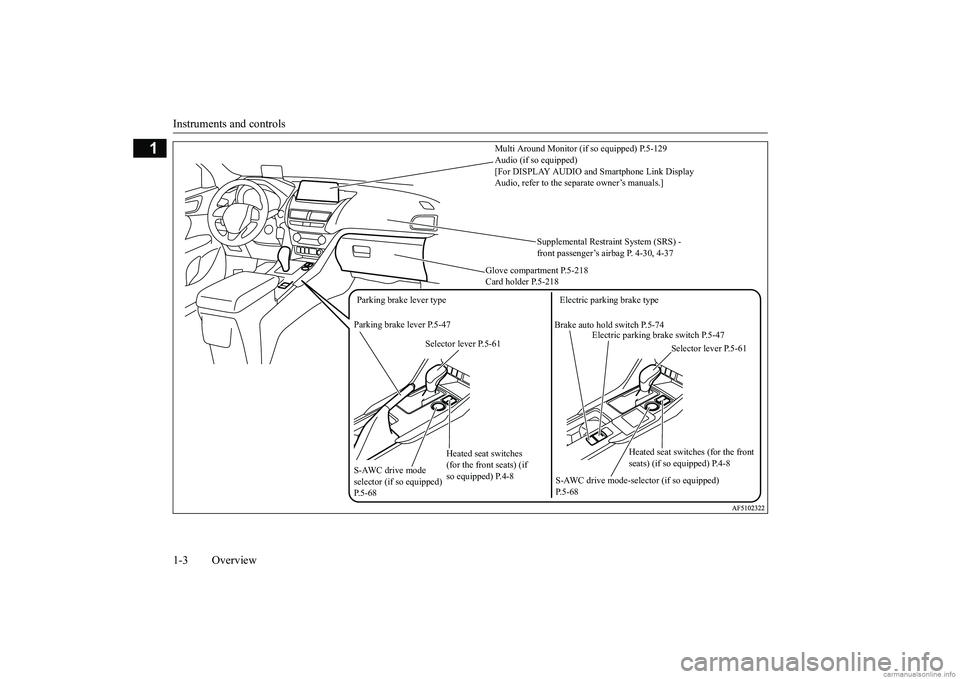
Instruments and controls 1-3 Overview
1
Supplemental Restraint System (SRS) - front passenger’s airbag P. 4-30, 4-37
Glove compartment P.5-218 Card holder P.5-218
S-AWC drive mode-selec
tor (if so equipped)
P.5-68
Parking brake lever P.5-47
Heated seat switches (for the front seats) (if so equipped) P.4-8
Selector lever P.5-61
Brake auto hold switch P.5-74
S-AWC drive mode selector (if so equipped)P.5-68
Electric parking brake type
Parking brake lever type
Heated seat switches (for the front seats) (if so equipped) P.4-8
Electric parking brake switch P.5-47
Selector lever P.5-61
Multi Around Monitor (if
so equipped) P.5-129
Audio (if so equipped) [For DISPLAY AUDIO and Smartphone Link Display Audio, refer to the sepa
rate owner’s manuals.]
BK0252700US.bo
ok 3 ページ 2017年10月4日 水曜日 午後4時54分
Page 6 of 417
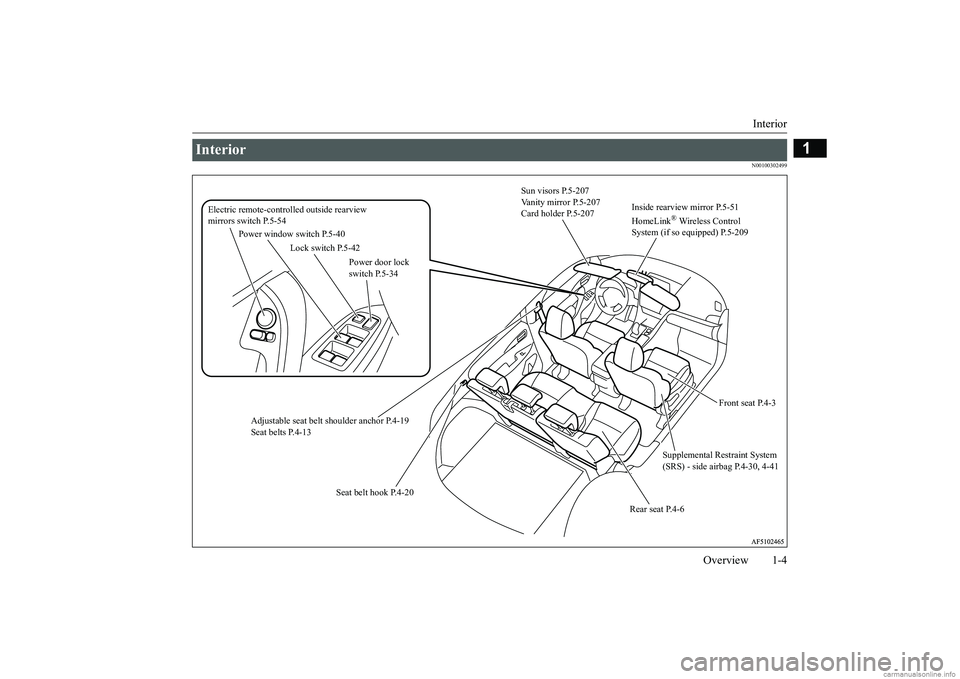
Interior
Overview 1-4
1
N00100302499
Interior
Sun visors P.5-207 Vanity mirror P.5-207 Card holder P.5-207
Supplemental Restraint System (SRS) - side airbag P.4-30, 4-41
Adjustable seat belt
shoulder anchor P.4-19
Seat belts P.4-13
Electric remote-controlled outside rearview mirrors switch P.5-54
Lock switch P.5-42
Power door lock switch P.5-34
Power window switch P.5-40
Rear seat P.4-6
Front seat P.4-3
Inside rearview mirror P.5-51 HomeLink
® Wireless Control
System (if so equipped) P.5-209
Seat belt hook P.4-20
BK0252700US.bo
ok 4 ページ 2017年10月4日 水曜日 午後4時54分
Page 22 of 417
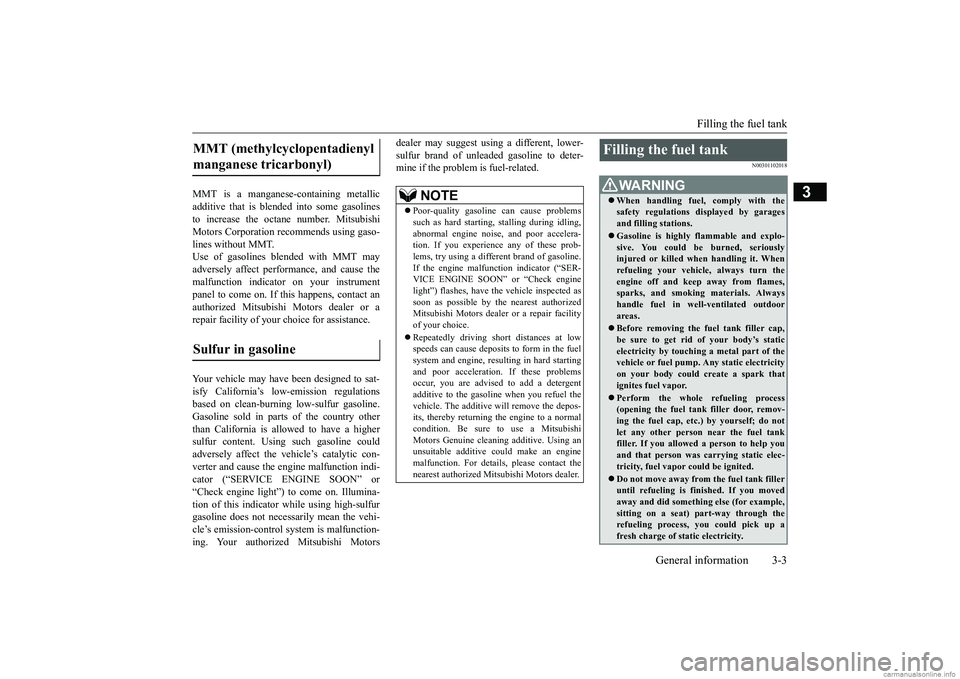
Filling the fuel tank
General information 3-3
3
MMT is a manganese-containing metallic additive that is blended into some gasolines to increase the octane number. Mitsubishi Motors Corporation recommends using gaso-lines without MMT. Use of gasolines blended with MMT may adversely affect performance, and cause themalfunction indicator on your instrumentpanel to come on. If this happens, contact an authorized Mitsubishi Motors dealer or a repair facility of your choice for assistance. Your vehicle may have been designed to sat- isfy California’s low-emission regulationsbased on clean-burning low-sulfur gasoline. Gasoline sold in parts of the country other than California is allowed to have a highersulfur content. Using such gasoline could adversely affect the vehicle’s catalytic con- verter and cause the engine malfunction indi-cator (“SERVICE ENGINE SOON” or “Check engine light”) to come on. Illumina- tion of this indicator while using high-sulfurgasoline does not necessarily mean the vehi- cle’s emission-control system is malfunction- ing. Your authorized Mitsubishi Motors
dealer may suggest using a different, lower- sulfur brand of unleaded gasoline to deter- mine if the problem is fuel-related.
N00301102018
MMT (methylcyclopentadienyl manganese tricarbonyl) Sulfur in gasoline
NOTE
Poor-quality gasoline can cause problems such as hard starting, stalling during idling, abnormal engine noise, and poor accelera- tion. If you experience any of these prob-lems, try using a different brand of gasoline. If the engine malfunction indicator (“SER- VICE ENGINE SOON” or “Check enginelight”) flashes, have the vehicle inspected as soon as possible by the nearest authorized Mitsubishi Motors dealer or a repair facilityof your choice. Repeatedly driving short distances at low speeds can cause deposits to form in the fuel system and engine, resulting in hard starting and poor acceleration. If these problemsoccur, you are advised to add a detergent additive to the gasoline when you refuel the vehicle. The additive will remove the depos-its, thereby returning the engine to a normal condition. Be sure to use a Mitsubishi Motors Genuine cleaning additive. Using anunsuitable additive could make an engine malfunction. For details, please contact the nearest authorized Mitsubishi Motors dealer.
Filling the fuel tank
WA R N I N G When handling fuel, comply with the safety regulations displayed by garages and filling stations. Gasoline is highly flammable and explo- sive. You could be burned, seriously injured or killed when handling it. Whenrefueling your vehicle, always turn the engine off and keep away from flames, sparks, and smoking materials. Alwayshandle fuel in well-ventilated outdoor areas. Before removing the fuel tank filler cap, be sure to get rid of your body’s static electricity by touching a metal part of thevehicle or fuel pump. Any static electricity on your body could create a spark that ignites fuel vapor. Perform the whole refueling process (opening the fuel tank filler door, remov-ing the fuel cap, etc.) by yourself; do not let any other person near the fuel tank filler. If you allowed a person to help youand that person was carrying static elec- tricity, fuel vapor could be ignited. Do not move away from the fuel tank filler until refueling is finished. If you movedaway and did something else (for example, sitting on a seat) part-way through the refueling process, you could pick up afresh charge of static electricity.
BK0252700US.bo
ok 3 ページ 2017年10月4日 水曜日 午後4時54分
Page 23 of 417
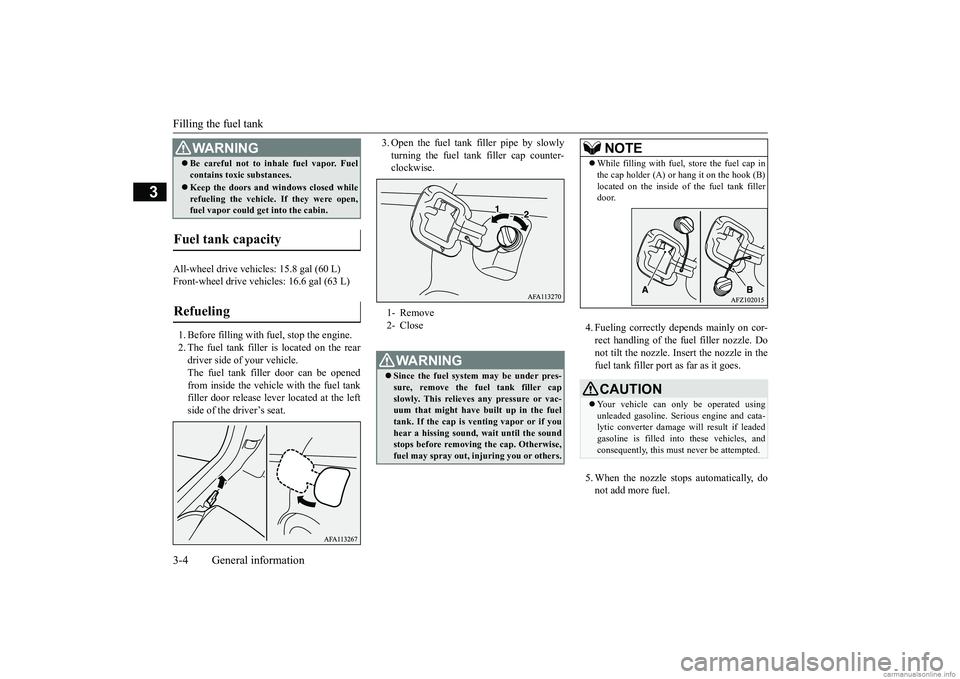
Filling the fuel tank 3-4 General information
3
All-wheel drive vehicles: 15.8 gal (60 L) Front-wheel drive vehicles: 16.6 gal (63 L) 1. Before filling with fuel, stop the engine. 2. The fuel tank filler is located on the rear driver side of your vehicle. The fuel tank filler door can be openedfrom inside the vehicle with the fuel tank filler door release le
ver located at the left
side of the driver’s seat.
3. Open the fuel tank filler pipe by slowly turning the fuel tank filler cap counter- clockwise.
4. Fueling correctly depends mainly on cor- rect handling of the fuel filler nozzle. Do not tilt the nozzle. Insert the nozzle in thefuel tank filler port as far as it goes. 5. When the nozzle stops automatically, do not add more fuel.
Be careful not to inhale fuel vapor. Fuel contains toxic substances. Keep the doors and windows closed while refueling the vehicle. If they were open,fuel vapor could get into the cabin.
Fuel tank capacity Refueling
WA R N I N G
1- Remove 2- CloseWA R N I N G Since the fuel system may be under pres- sure, remove the fuel tank filler cap slowly. This relieves any pressure or vac- uum that might have built up in the fueltank. If the cap is venting vapor or if you hear a hissing sound, wait until the sound stops before removing the cap. Otherwise,fuel may spray out, injuring you or others.
NOTE
While filling with fuel, store the fuel cap in the cap holder (A) or hang it on the hook (B) located on the inside of the fuel tank filler door.CAUTION Your vehicle can only be operated using unleaded gasoline. Serious engine and cata- lytic converter damage will result if leadedgasoline is filled into these vehicles, and consequently, this must never be attempted.
BK0252700US.bo
ok 4 ページ 2017年10月4日 水曜日 午後4時54分
Page 33 of 417
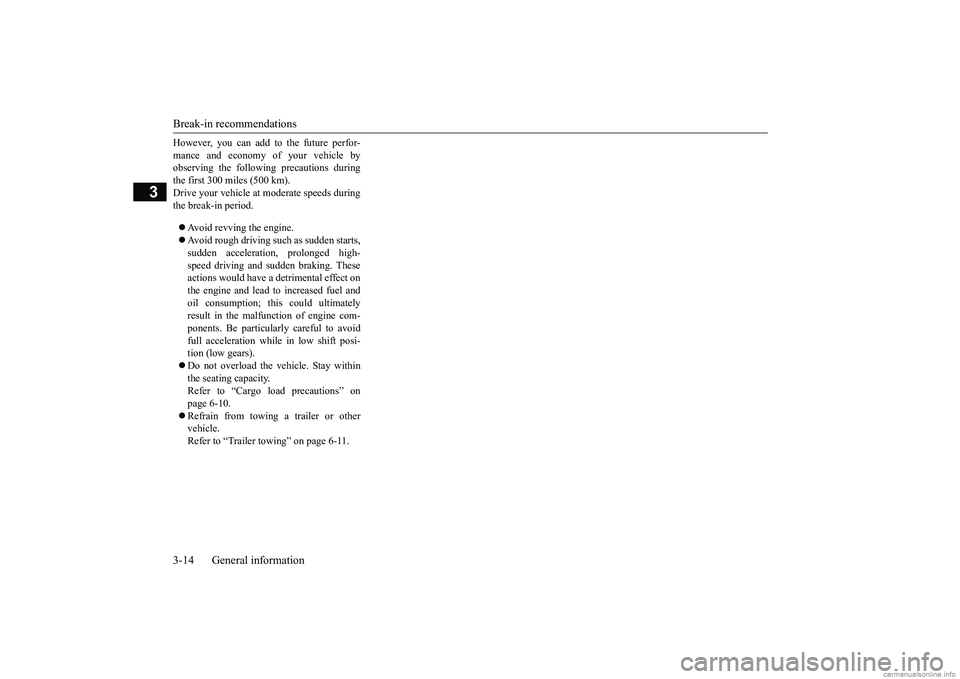
Break-in recommendations 3-14 General information
3
However, you can add to the future perfor- mance and economy of your vehicle by observing the follow
ing precautions during
the first 300 miles (500 km).Drive your vehicle at moderate speeds during the break-in period. Avoid revving the engine. Avoid rough driving such as sudden starts, sudden acceleration, prolonged high- speed driving and sudden braking. These actions would have a detrimental effect onthe engine and lead to increased fuel andoil consumption; this could ultimately result in the malfunction of engine com- ponents. Be particularly careful to avoidfull acceleration while in low shift posi- tion (low gears). Do not overload the vehicle. Stay within the seating capacity. Refer to “Cargo load precautions” on page 6-10. Refrain from towing a trailer or other vehicle. Refer to “Trailer towing” on page 6-11.
BK0252700US.bo
ok 14 ページ 2017年10月4日 水曜日 午後4時54分
Page 34 of 417
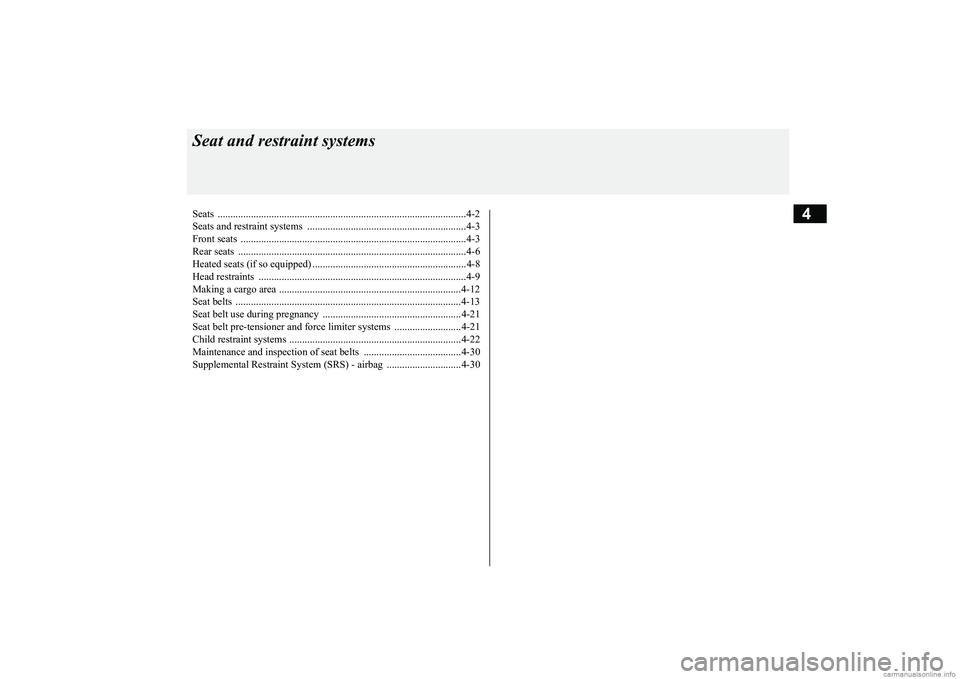
4
Seat and restraint systemsSeats ..........................................
.......................................................4-2
Seats and restraint syst
ems ..............................................................4-3
Front seats .......................
.................................................................4-3
Rear seats ........................
.................................................................4-6
Heated seats (if so e
quipped) ............................................................4-8
Head restraints ......
.................................................
..........................4-9
Making a cargo area ........
...............................................................4-12
Seat belts .........................
...............................................................4-13
Seat belt use during preg
nancy ......................................................4-21
Seat belt pre-tensioner and fo
rce limiter systems ..........................4-21
Child restraint system
s ...........................................
........................4-22
Maintenance and inspection of seat belts ......................................4-30 Supplemental Restraint System (SRS) - airbag .............................4-30
BK0252700US.bo
ok 1 ページ 2017年10月4日 水曜日 午後4時54分
Page 36 of 417
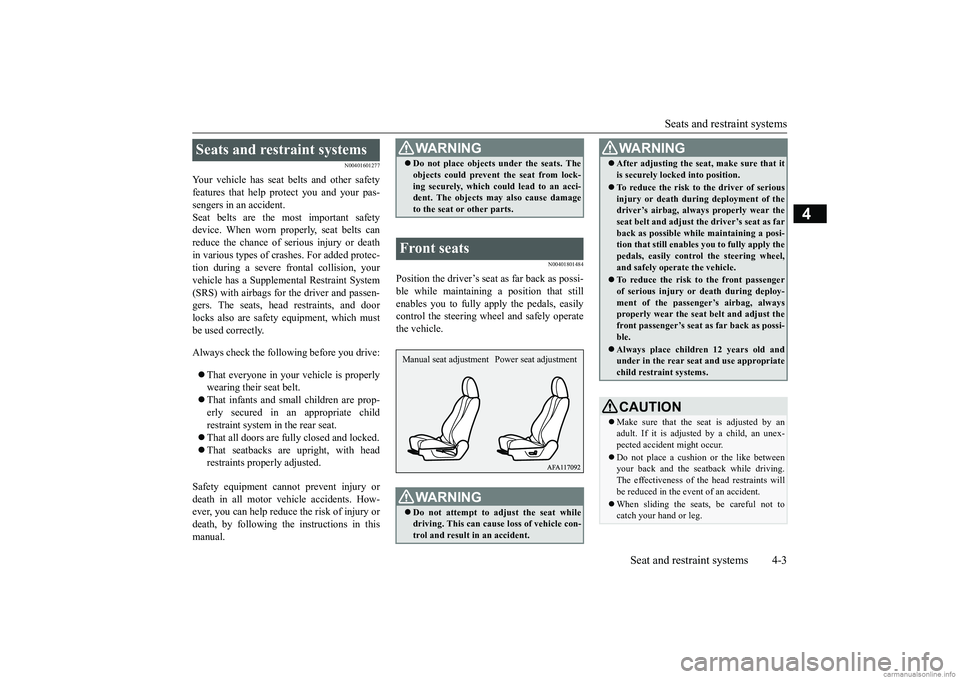
Seats and restraint systems
Seat and restraint systems 4-3
4
N00401601277
Your vehicle has seat belts and other safety
features that help protect you and your pas-
sengers in an accident.
Seat belts are the most important safety
device. When worn properly, seat belts can
reduce the chance of serious injury or death
in various types of crashes. For added protec-
tion during a severe frontal collision, your
vehicle has a Supplemental Restraint System
(SRS) with airbags for the driver and passen-
gers. The seats, head restraints, and door
locks also are safety equipment, which must
be used correctly.
Always check the following before you drive: That everyone in your vehicle is properly
wearing their seat belt.
That infants and small children are prop-
erly secured in an appropriate child
restraint system in the rear seat.
That all doors are fully closed and locked.
That seatbacks are upright, with head
restraints properly adjusted.
Safety equipment cannot prevent injury or
death in all motor vehicle accidents. How-
ever, you can help reduce the risk of injury or
death, by following the instructions in this
manual.
N00401801484
Position the driver’s seat as far back as possi-
ble while maintaining a position that still
enables you to fully apply the pedals, easily
control the steering wheel and safely operate
the vehicle.
Seats and restraint systems
WA R N I N G Do not place objects under the seats. The
objects could prevent the seat from lock-
ing securely, which could lead to an acci-
dent. The objects ma y also cause damage
to the seat or other parts.Front seats
WA R N I N G Do not attempt to adjust the seat while
driving. This can cause loss of vehicle con-
trol and result in an accident.Manual seat adjustment Power seat adjustment
After adjusting the seat, make sure that it
is securely locked into position.To reduce the risk to the driver of serious
injury or death during deployment of the
driver’s airbag, always properly wear the
seat belt and adjust th e driver’s seat as far
back as possible while maintaining a posi-
tion that still enables you to fully apply the
pedals, easily control the steering wheel,
and safely operate the vehicle. To reduce the risk to the front passenger
of serious injury or death during deploy-
ment of the passenger’s airbag, always
properly wear the seat belt and adjust the
front passenger’s seat as far back as possi-
ble.Always place children 12 years old and
under in the rear seat and use appropriate
child restraint systems.CAUTIONMake sure that the seat is adjusted by an
adult. If it is adjusted by a child, an unex-
pected accident might occur.Do not place a cushion or the like between
your back and the seatback while driving.
The effectiveness of the head restraints will
be reduced in the event of an accident.When sliding the seats, be careful not to
catch your hand or leg.WA R N I N G
BK0252700US.book 3 ページ 2017年10月5日 木曜日 午後6時49分
Page 37 of 417
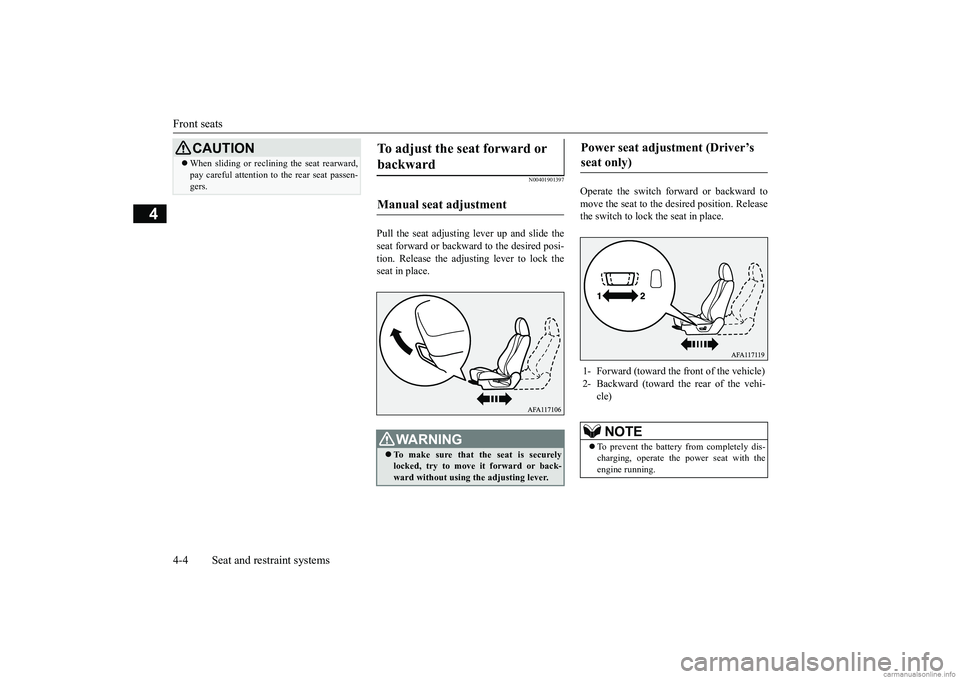
Front seats 4-4 Seat and restraint systems
4
N00401901397
Pull the seat adjusting lever up and slide the seat forward or backward to the desired posi- tion. Release the adjusting lever to lock the seat in place.
Operate the switch forward or backward to move the seat to the desired position. Release the switch to lock the seat in place.
When sliding or reclining the seat rearward, pay careful attention to the rear seat passen- gers.CAUTION
To adjust the seat forward or backward Manual seat adjustment
WA R N I N G To make sure that the seat is securely locked, try to move it forward or back- ward without using the adjusting lever.
Power seat adjustment (Driver’s seat only) 1- Forward (toward the front of the vehicle) 2- Backward (toward the rear of the vehi-
cle)NOTE
To prevent the battery from completely dis- charging, operate the power seat with theengine running.
BK0252700US.bo
ok 4 ページ 2017年10月4日 水曜日 午後4時54分
Page 40 of 417

Rear seats
Seat and restraint systems 4-7
4
Pull the seat adjusting lever up and slide the seat forward or backwa
rd to the desired posi-
tion. Release the adjusting lever to lock the seat in place.
N00402801032
Pull the lever up and adjust the seatback by hand to the desired position, and release the lever. The seatback will lock in place.
To adjust the seat forward or backward
NOTE
You can adjust the seat forward or backward on either side separately.WA R N I N G To make sure that the seat is securely locked, try to move it forward or back-ward without using the adjusting lever.
CAUTION When sliding the rear seat rearward, make sure that there are no items behind the seat.
To adjust the seatbacks
CAUTION If your vehicle is equipped with the arm rest and the seatback is reclined while the drink holder is used, drinks could be spilled. If the spilt drink is very hot, you could be burnt.
NOTE
You can adjust the seatback forward or back- ward on either side separately. If your vehicle is equipped with the cargo area cover, the seatbacks cannot be reclinedunless the cargo area cover is installed in the rear position or removed. Refer to “Cargo area cover” on page 5-220.WA R N I N G To reduce the risk of serious injury or death in the event of an accident or sud- den stop, all seatbacks should be kept inthe upright position while the vehicle is in motion. Seat belt performance during an accident can be adversely affected if the seatbacks are reclined. The more a seatback isreclined, the more likely seat belt perfor- mance will be adversely affected. If the seat belt is not properly positioned againstthe body during an accident, there is increased risk you will slide under the belt and receive serious injury or death. When a person is sitting in the center seat- ing position of the rear seats, the two sides of the rear seats must have the same for- ward/backward position and the sameseatback angle.
BK0252700US.bo
ok 7 ページ 2017年10月4日 水曜日 午後4時54分